Updated: January 2025 | Author: Dr. Khushbu Jain | Reviewed by: Dr. Anant Bagul (Orthopedic surgeon and stemcell specialist)
Do you know that you can lose your vision slowly or abruptly because of damage to the nerves in your eyes?
Losing your vision means you need others’ help to do your daily activities. You cannot be self-reliant anymore.
While conventional medical science offers limited solutions, advancements in stem cell therapy have opened new possibilities for optic nerve regeneration in India.
You can come out from the constant struggle of the deterioration of your vision and live a more fulfilling and confident life.
Before we start our discussion on the solution part let’s first briefly understand the optic nerve damage.
What is Optic Nerve Damage?
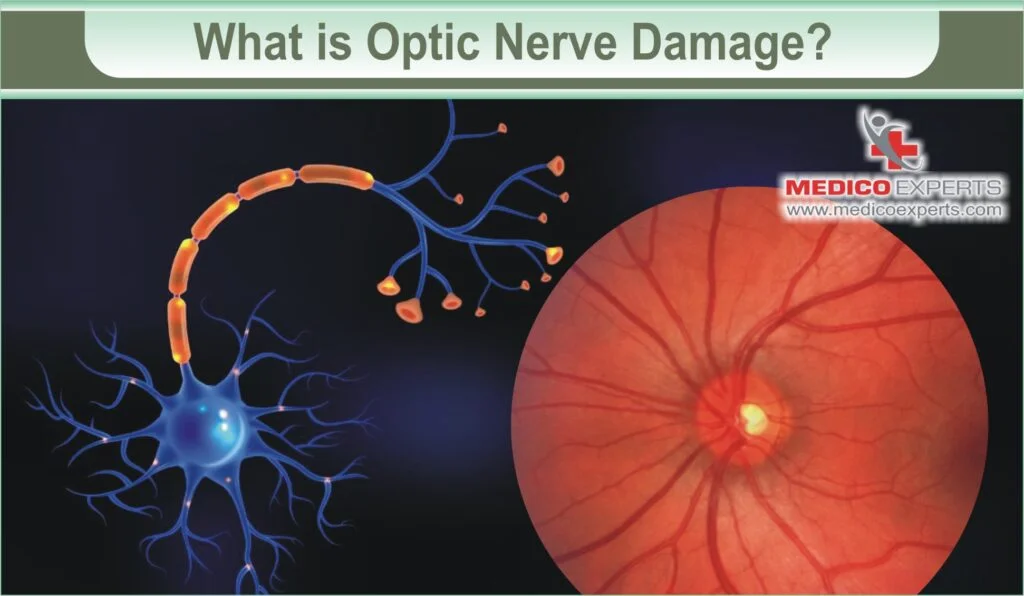
The optic nerve is crucial for transmitting visual information from the retina to the brain. Optic nerve damage occurs when immune cells attack this nerve, disrupting this connection. This can result from conditions like:
- Multiple Sclerosis (MS): An immune system disorder.
- Lupus: Another autoimmune disease.
- Infections or trauma.
Understanding this damage is the first step toward exploring treatment options. Let’s look at the symptoms and causes of optic nerve damage.
What are the symptoms of Optic Nerve Damage?
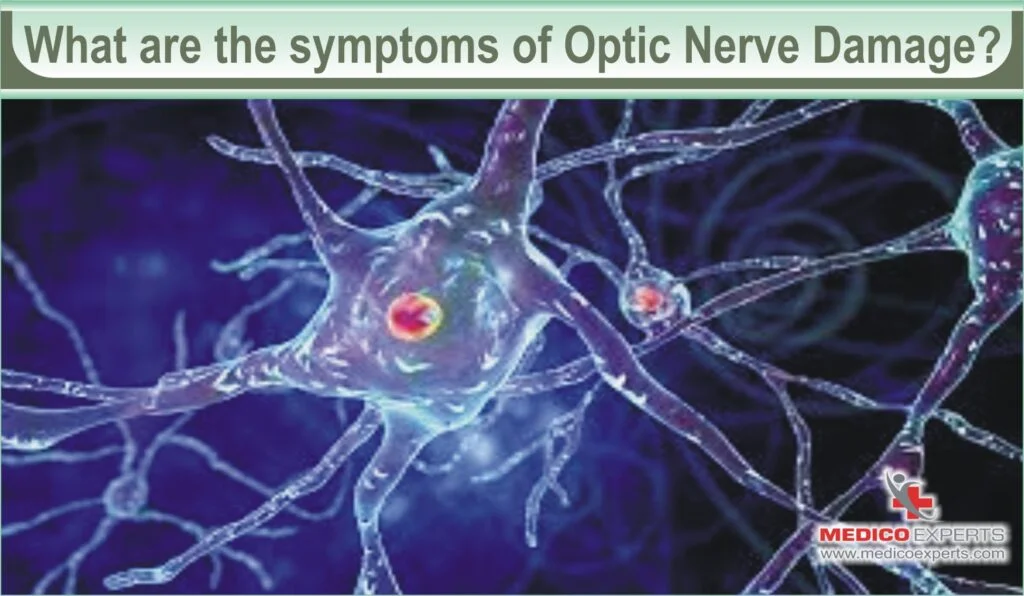
These are the symptoms of optic nerve damage:
- Pain in the eye while rotating the eyeball
- The problem with seeing colours
- Reduced vision
- Seeing flashlights
- Blurred vision
- Problem with central vision and peripheral vision
Do you wonder, what causes optic nerve damage?
Let’s understand the probable cause of optic nerve damage.
What are the causes of Optic Nerve Damage?
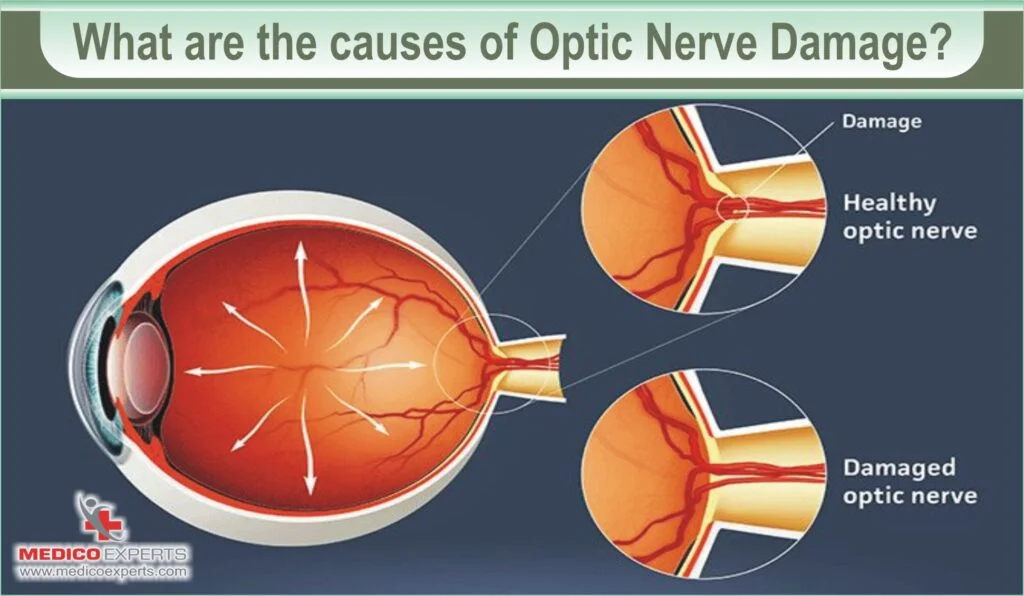
Different diseases can cause optic nerve damage. Some of the diseases are listed below.
Glaucoma
Glaucoma is a very common eye disorder where the optic nerve within your eye gets affected because of a sudden increase in intraocular pressure. This disease may be detected at a later stage when loss of vision has already started.
Trauma
If you face an injury in your eye, you may suffer from optic nerve damage. Head injury can also result in partial or complete blindness.
Autoimmune Disease
Optic neuritis can result from multiple sclerosis – an autoimmune condition that affects the covering layer of the optic neurons. It can also occur as a result of bacterial and viral infections like measles and herpes.
Other autoimmune conditions that affect the eyes are lupus and Behcet’s disease.
Blood Flow Issues To The optic Nerve
Ischemic optic neuropathy occurs due to a lack of proper blood flow to the optic nerves. This condition can be caused by dilation or obstruction of small arteries carrying blood to the eye. There may be sudden blindness in the eye.
Tumours
Tumours can cause damage to the optic nerve by exerting pressure on it.
Vascular Disorders
Vascular disorders like hypertension can lead to optic nerve swelling and restricted blood flow to the optic nerve can aggravate problems further.
Knowing about the causes of optic nerve damage will make you take the right action at the right time much before partial blindness starts in your eye.
Let’s now know about the diagnostic procedures.
What is the diagnostic procedure for Optic Nerve Damage?
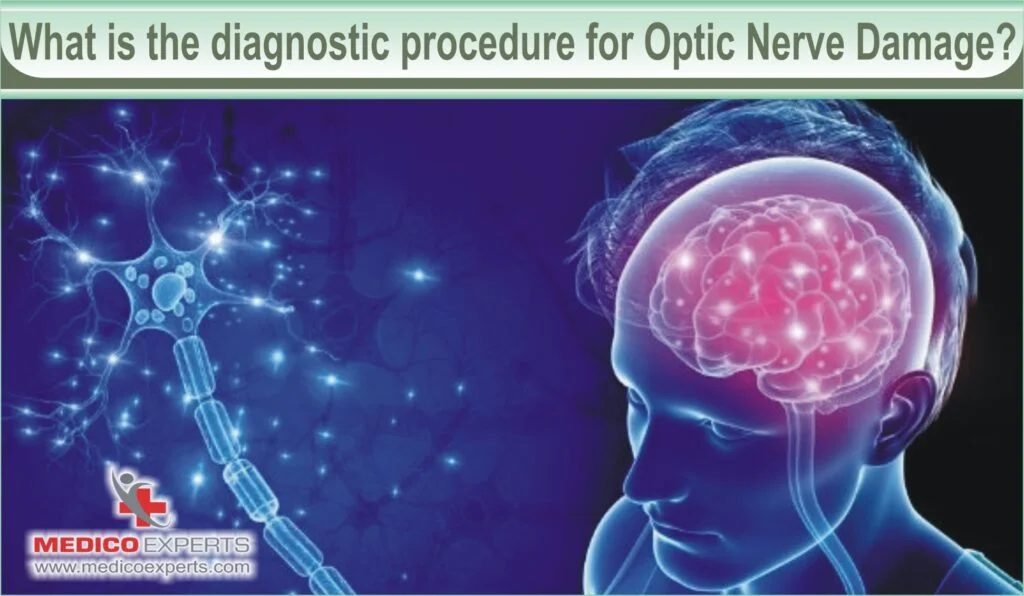
Diagnosis of optic nerve defects can be made through diagnostic scans, vision tests, MRIs, and optic scans known as optic coherence tomography.
Here are the steps for diagnosis:
Step 1: Vision Test
The doctor will test your central and peripheral vision.
Step 2: Ophthalmoscopy
In this type of test, the doctor uses a bright light to examine the optic disc in your eye.
Step 3: Light Reaction Test
In this type of test, the contraction of the pupil of the eye is observed.
Step 4: MRI
MRI tests can determine the problem with the optic nerve very precisely.
Step 5: Optic Coherence Tomography
Optic nerve problems can also be detected using optic coherence tomography which uses light waves to view the cross-section of the retina and the optic nerve.
Now that we have known about the diagnostic procedures, let’s move on to the treatment strategies of optic nerve regeneration.
Treatment Strategies for Optic Nerve Damage
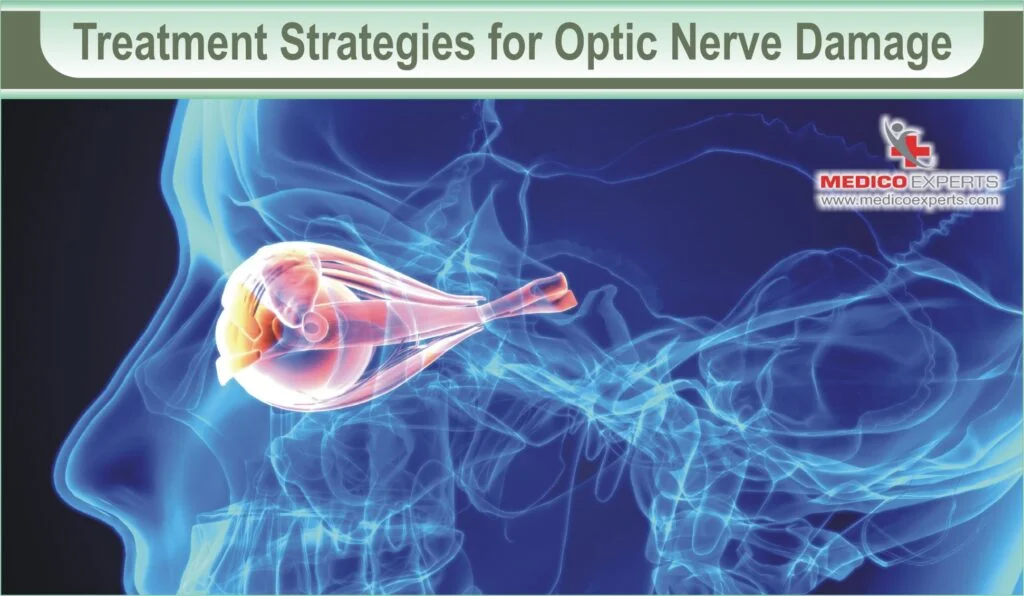
The following section covers both the conventional and advanced treatments of optic nerve damage.
1. Current Conventional Treatment Approach in Optic Nerve Atrophy
The main optic nerve treatment approach in retinal degeneration is to decrease your intraocular pressure or the IOP.
Certain medications such as beta blockers and prostaglandins are given to generally reduce the production of aqueous fluid and to facilitate drainage of the excess fluid produced in the eye.
In a few cases of glaucoma, your doctor can also have laser surgery to drain the fluid from the eye.
2. Advanced Treatments with Stem Cell Therapy for Optic Nerve Regeneration
Stem cell therapy can regenerate your retinal cells and is an advanced treatment for optic nerve atrophy.
Stem cells are the basic building blocks of human beings. These are the cells which are having the capability to multiply themselves and can also generate different functional cells.
These are the cells that transform a zygote (the first indication of life in the womb – which is a combination of four stem cells) into a human baby in nine months.
Though stem cells are of many kinds, the stem cells that are used in optic nerve treatment are known as mesenchymal stem cells.
What are Mesenchymal Stem Cells?
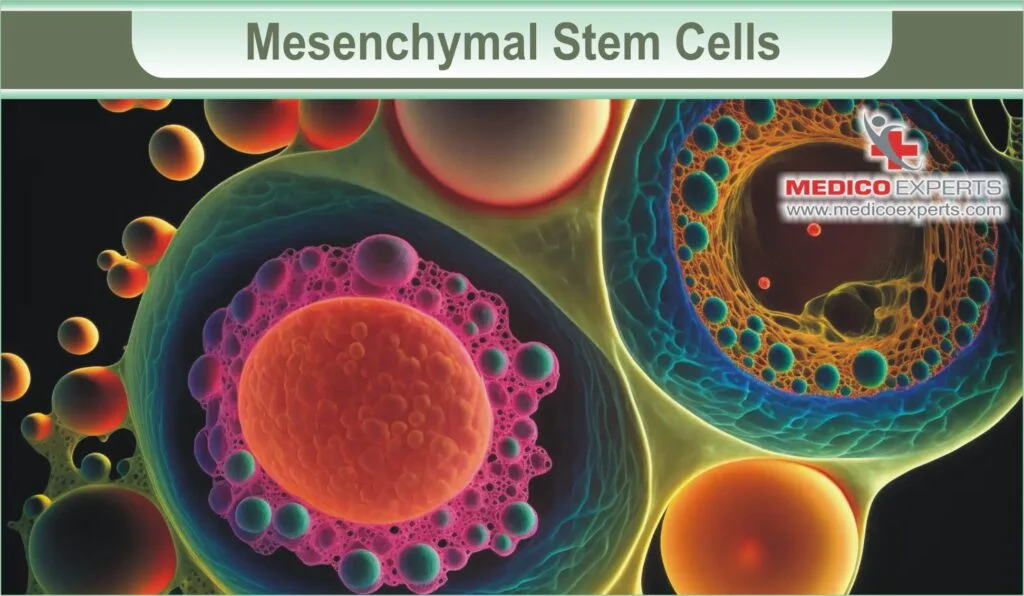
Mesenchymal stem cells are pluripotent stem cells which means – they can take the role of multiple cell types including neuronal cells.
Mesenchymal stem cells can be extracted and isolated from the umbilical cord, adipocytes, and bone marrow.
Now that you have understood what is mesenchymal stem cells, let us understand about nerve cells in the eyes which are regenerated by mesenchymal stem cell transplantation or optic nerve repair.
What are Retinal Ganglion Cells?
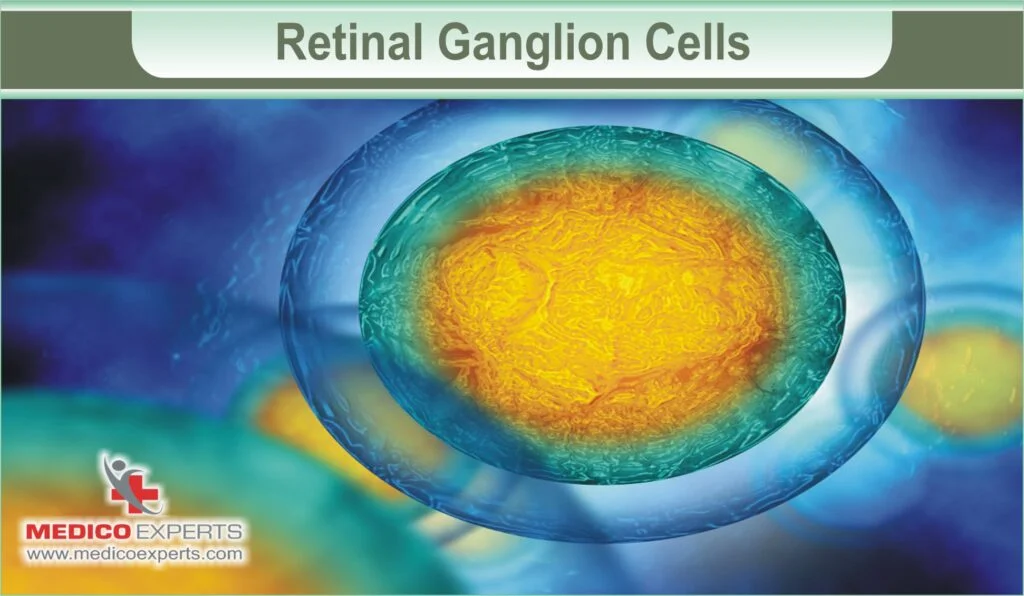
Retinal ganglion cells are neuronal cells present on the inner surface of the retina. They receive visual signals from the photoreceptor cells.
The retinal ganglion cells have a long axon that carries visual information from the eye to the mid-brain, thalamus, or hypothalamus ( parts of the brain) to make you perceive your vision.
Now, there are about a million retinal ganglion cells in your eye, but if they get weakened due to certain reasons, you are unable to see objects properly.
How does Stem Cell Therapy function to revive or generate weakened Retinal Ganglion Cells and Optic Atrophy?
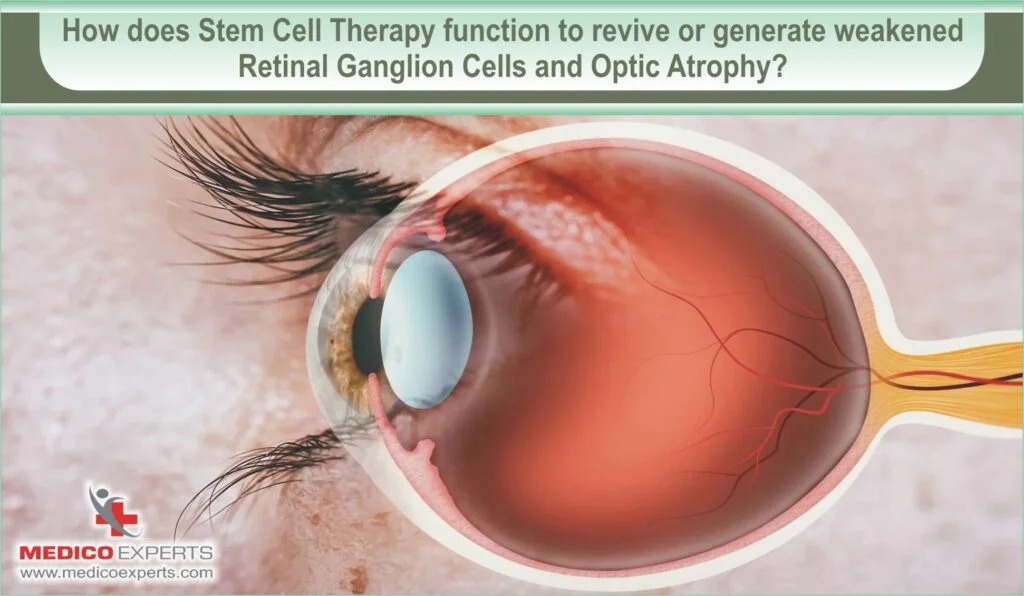
After transplanting the mesenchymal stem cells in the intravitreal space (space in the back of the eye called a vitreous cavity), they migrate to the retina and start secreting various neurotrophic factors which are growth factors responsible for axon regeneration.
Studies have suggested that the mesenchymal stem cells secrete extracellular vesicles (cell-derived carriers of active molecules to recipient cells) which can prevent apoptosis or cell death of retinal ganglion cells preventing optic atrophy.
Researchers concluded in their studies that stem cells have the potential to restore normal niches inside the retina, by either integrating into the retina or creating a normal environment for the conduction of neuronal impulses ( by secreting a component called BDNF or other neurotrophic factors like neurotrophin).
The good news is that a clinical trial on stem cells for regenerating retinal cells has been performed in some countries and the latest research has met with success.
Advantages and effects of using stem cells for Optic Nerve Regeneration
One of the main advantages of using MSCs (Mesenchymal stem cells) is that they do not cause any rejection by your body.
Another advantage is that you do not get any side effects from the treatment.
However, there are two points which you may like to know. One is the place of transferring the stem cells. Transfer in the retinal space is very effective, as the chances of the MSCs getting integrated into the retinal environment are high. However, this procedure is slightly complicated. On the other hand transfer of MSCs in the intravetrial space is very safe and can be performed easily.
Lastly, the effect of the transfer of stem cells depends on the stage of the disease. The stem cells may not be able to revive the dead retinal ganglion cells, but according to the research they can even be applied to patients at a later stage when optic nerve atrophy has started and less vision has remained.
Takeaway

Stem cell therapy provides a solution to optic atrophy. These cells possess the ability to regenerate damaged nerves and restore your vision.
It can lower challenges related to central and peripheral vision, nighttime vision, and color differentiation. The capacity of stem cells to generate new neuronal cells offers a solution to vision disabilities and paves the way for optic nerve repair.
Frequently Asked Questions (FAQs)
Q1. Can stem cells repair Optic Nerve Damage?
A: Yes, stem cells, particularly mesenchymal stem cells can repair optic nerve damage.
Q2. Can optic nerve be regenerated?
A: Yes, the optic nerve can be regenerated by intravitreal stem cell therapy.
Q3. What is the best treatment for Optic Nerve Damage?
A: Stem cell treatment is the best for optic nerve damage.
Q4. Is optic nerve damage permanent?
A: If the optic nerve damage is not managed timely, the damage can be permanent.
Q5. What type of stem cell can repair nerve damage?
A: Mesenchymal stem cells can repair nerve damage.
References
- https://www.ncbi.nlm.nih.gov/pmc/articles/PMC2701125/
- https://www.mdpi.com/2673-8392/3/1/7
- https://link.springer.com/article/10.1007/s40135-019-00194-0
- https://www.sciencedirect.com/science/article/abs/pii/S0223523421006917
- https://www.sciencedirect.com/science/article/pii/S266737622400009X
- https://www.ncbi.nlm.nih.gov/pmc/articles/PMC8540760/
- https://www.ncbi.nlm.nih.gov/pmc/articles/PMC10383000/
Recommended Articles For You
- Stem Cell Therapy in India: A Revolutionary Approach to HealingImagine a world where degenerative disorders, chronic diseases, and traumatic injuries could be treated and … Continue reading Stem Cell Therapy in India: A Revolutionary Approach to Healing
- Stem Cell Therapy Process For Vision: Is It Right For You?Do you want to treat your vision issues and want a solution that is beyond … Continue reading Stem Cell Therapy Process For Vision: Is It Right For You?
- Say Yes To Freedom: Mobility Aids For Muscular DystrophyIf you are fighting with muscular dystrophy, moving freely and doing your daily tasks without … Continue reading Say Yes To Freedom: Mobility Aids For Muscular Dystrophy
- Nutrition Tips And Diet For Muscular Dystrophy: Building Strength With Every BiteIt is unimaginable for many that people fighting with muscular dystrophy struggle while performing daily … Continue reading Nutrition Tips And Diet For Muscular Dystrophy: Building Strength With Every Bite
- Early Signs Of Muscular Dystrophy And When To See A DoctorIt is hard to watch your child struggle with everyday activities like climbing stairs, running, … Continue reading Early Signs Of Muscular Dystrophy And When To See A Doctor
- Can MND Be Cured? A Deep Dive Into Treatment OptionsCan MND be cured? It is a question that obviously comes to your mind when … Continue reading Can MND Be Cured? A Deep Dive Into Treatment Options
Recommendations to understand different treatments
News for you – Even Blood cancer is not listed as incurable disease in the present and future because of advancement in stem cell therapy. Stem cell therapy is opening…..Read More
Looking back at the 19th and 20th century, innovations and cutting edge technologies have been developed in neither space nor computer sciences, but in the…..Read More
Medically Reviewed By MedicoExperts Editorial & Clinical Review Board
Medical Disclaimer: This content is for informational purposes only and does not constitute medical advice, diagnosis, or treatment. Always consult a qualified healthcare provider for personalized guidance and recommendations regarding optic nerve damage or any other medical condition. Results from treatments like stem cell therapy may vary.



